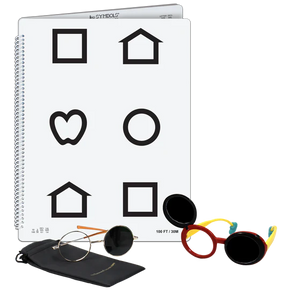
LEA SYMBOLS® Low Vision Book
This low vision book with LEA SYMBOLS® pediatric optotypes is designed for testing severely visually impaired children and adults. The complete book includes testing at 10 ft (3 meters), 5 ft (1...

 US FDA Registered
US FDA Registered






This Low Vision book with LEA NUMBERS® is designed for testing severely visually impaired children and adults. This complete book includes testing at 10 ft (3 meters), 5 ft (1.5 meters) and for near vision testing at 16" (40 cm). Distance testing line sizes range from 20/1600 to 20/16 equivalent. Near vision testing line sizes range from 20/800 to 20/16 equivalent.
The LEA NUMBERS® Low Vision book can be purchased with binding either on the left side or top. The book can also be purchased alone or as part of a set. Set includes pediatric occluding glasses and metal-framed adult occluding glasses.
When comparing visual acuity results with ETDRS, study results suggest the LEA NUMBERS® Low Vision Book has a slight advantage over the Feinbloom chart when testing individuals with vision impairment.
Click here for the NSUOCO Comparison Study.
Note: All products sold on Accuspire.com should be used by qualified clinician and should be purchased by or on order of a qualified clinician.






This low vision book with LEA SYMBOLS® pediatric optotypes is designed for testing severely visually impaired children and adults. The complete book includes testing at 10 ft (3 meters), 5 ft (1...

This test is designed for testing children and adults with visual impairment at a distance of one meter. The LEA NUMBERS® in this assessment tool include the largest numbers, 50M in size,...

These five LEA NUMBERS® Cards can be used for presentation as single optotypes or arranged in a row as a line test. When the cards are next to each other, the space between the numbers is equal...

The Single Number Book is ideal for situations in which the child/adult cannot perform when tested with a line test. This book can help determine the best resolution of the visual pathway in a...

This chart featuring LEA NUMBERS® is designed to measure visual acuity with a standard line test and with three tighter spaced tests; 50%, 25%, and 12.5% which often reveal difficulties in...

This low vision book with LEA SYMBOLS® pediatric optotypes is designed for testing severely visually impaired children and adults. The complete book includes testing at 10 ft (3 meters), 5 ft (1...

This test is designed for testing children and adults with visual impairment at a distance of one meter. The LEA NUMBERS® in this assessment tool include the largest numbers, 50M in size,...

These five LEA NUMBERS® Cards can be used for presentation as single optotypes or arranged in a row as a line test. When the cards are next to each other, the space between the numbers is equal...

The Single Number Book is ideal for situations in which the child/adult cannot perform when tested with a line test. This book can help determine the best resolution of the visual pathway in a...

This chart featuring LEA NUMBERS® is designed to measure visual acuity with a standard line test and with three tighter spaced tests; 50%, 25%, and 12.5% which often reveal difficulties in...

Discounted Prices








